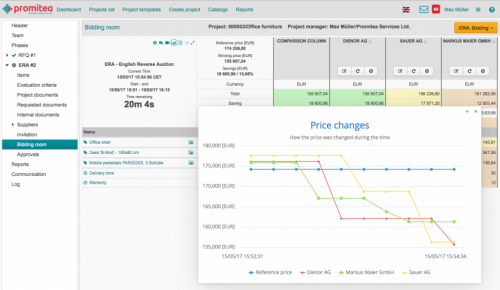Part 2 - Sourcing
Series of articles on digitization of purchase:
- Digitization of procurement processes strengthens the company's competitiveness (introductory part)
- Part 1 - SRM for Strategic Purchasing
- Part 2 - Sourcing for operative purchasing
- Part 3 - Procurement for Catalog Purchasing
Sourcing includes requests, tenders, and auctions. It is typically used to purchase so-called leverage products for direct spend. For these products, there is a market with several competing alternative suppliers that are interchangeable from the purchasing point of view.
Traditionally, a sourcing project consists of the following steps:
Generation of a Request for Information (RFI) addressed to selected and approved suppliers. It consists of
- Organizational data (addresses, communication parameters, contact persons)
- Description of the products requested and their quantities,
- Delivery conditions, time specifications, and others.
The requests are sent to the selected suppliers by e-mail.
The suppliers react with their bids. Since their responses are not formatted uniformly, their manual evaluation is time-consuming.
In Promitea, the time required to create a request is minimized by:
- Transfer of data from requests that have already been executed
- Creation of requests based on existing templates
- Transfer of product descriptions from the ERP system to Promitea.
The same applies to the selection of suppliers and the control of electronic requests.
After receiving the request, the suppliers connect to Promitea using their browser. They limit their quotations to the price per item. This minimizes the effort involved in processing the RFI both on the purchasing side and on the supplier side and takes only minutes.
Promitea automatically evaluates the incoming quotations.
In simple cases, the purchase can be awarded based directly on RFI and the best bid. Otherwise, it is worthwhile to invite suppliers to tender (RFQ, Request for Quotation) after the RFI. For purchasing, these steps are limited to the following additions, based on the data of the request:
- Attach the best suppliers to a shortlist
- If necessary, supplement the non-monetary criteria (delivery times, payment terms, quality criteria) for multi-criteria evaluation of the offer.
- Supplementing other documents that the supplier must provide
- Definition of the best purchasing strategy (cherry picking vs. complete bid, sealed bids, multi-criteria evaluation of offers, evaluation only according to price)
The RFQ are distributed and the incoming bids automatically evaluated. RFQ process improves the best RFI bid by approximately 10%.
Note: It is possible to start right away with the RFQ and skip the RFI phase.
Depending on the situation, the project ends with the RFQ tender. However, it is advisable to let the electronic auction follow. The procedure will be extended only slightly.
- The number of suppliers can be further reduced.
- Additional criteria for the evaluation of tenders may be added
- Further functions are added (Cost Break Down, Total Cost of Ownership)
The suppliers are invited to the auction. A fixed time is set for the start of the auction.
Suppliers have the opportunity to improve their bid online during the auction. Here the suppliers see - without naming the supplier, of course - the best bid. This gives the suppliers the chance to outbid all other bids and to receive the order.
The duration of the online auction is typically set to 30 minutes with the possibility to extend it.
The typical course of the auction is shown in the following image:
The previous description refers to the so-called ERA (English Reverse Auction). In addition to this most common method, Promitea offers two other so-called ticker auction methods:
- DRA (Dutch Reverse Auction)
- JRA (Japan Reverse Auction).
Please contact us if you require further details or if you are interested in advice on strategic combinations of the various auction forms.
In addition to the savings achieved through electronic tendering, the auction also brings about a further 5% price improvement.
Promitea also offers other functions:
- A modular system of different reports
- Complete monitoring of all steps (log) initiated and executed by all users in the system during the course of the project so that you receive a complete proof of compliance.
Conclusion:
Sourcing is the most effective method for reducing goods prices while significantly reducing purchasing costs. After one day of training, your purchasers will be able to fully work with the system and achieve a ROI of several 100% in the first year of the operation.
Dr. František Bumba




